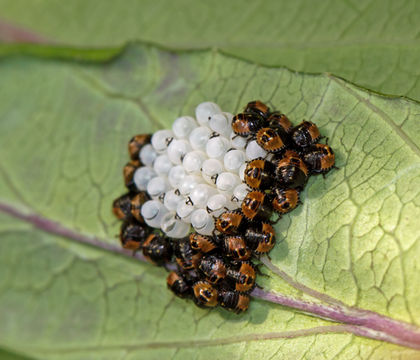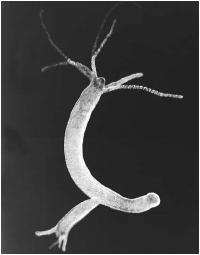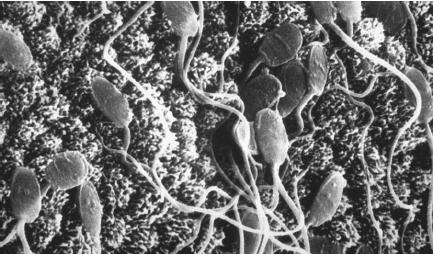Reproduction

Reproduction is the process by which plants and animals produce offspring. Reproduction may be asexual or sexual. Asexual reproduction occurs when a single cell divides to form two daughter cells that are genetically identical to the parent cell. Sexual reproduction involves the union of an egg (female sex cell) and sperm (male sex cell) to produce a cell that is genetically different than the parent cells.

Asexual reproduction
Asexual reproduction usually occurs by mitosis, a process in which the chromosomes in a cell's nucleus are duplicated before cell division. (Chromosomes are structures that organize genetic information in the nuclei of cells. Genes are units of hereditary information that control what traits are passed from one generation to another.) After the nucleus divides, the cytoplasm of the cell splits, forming two new daughter cells having nuclei with the same number and kind of chromosomes as the parent. Asexual reproduction occurs rapidly and can produce many individuals in a short amount of time. For example, some bacteria that reproduce in this way double their numbers every 20 minutes.
Bacteria, algae, most protozoa, yeast, dandelions, and flatworms all reproduce asexually. Yeasts reproduce asexually by budding, a process in which a small bulge, or bud, forms on the outer edge of a yeast cell and eventually separates, developing into a new cell. Flatworms and starfish can regrow an entire new organism from a piece of their body that is broken off, a process called fragmentation.
Words to Know
Budding: A form of asexual reproduction in which a small part of the parent's body separates and develops into a new individual.
Chromosome: Structures that organize genetic information in the nuclei of cells.
Cytoplasm: The semifluid substance of a cell containing organelles and enclosed by the cell membrane.
Diploid: Having two sets of chromosomes.
Fragmentation: The regeneration of an entire individual from a broken off piece of an organism.
Gamete: A male or female sex cell.
Gene: A section of a chromosome that carries instructions for the formation, functioning, and transmission of specific traits from one generation to another.
Haploid: Having a single set of unpaired chromosomes.
Meiosis: Process of cell division by which a diploid cell produces four haploid cells.
Mitosis: Process of cell division resulting in the formation of two daughter cells genetically identical to the parent cell.
Zygote: A diploid cell formed by the union of two haploid gametes.
Sexual reproduction
In plants and animals, sexual reproduction is the fusion of a sperm and egg, called gametes, from two different parents to form a fertilized egg called a zygote. Gametes are produced in the male testes and female ovaries by a process called meiosis. Meiosis is a type of cell division in which the number of chromosomes in a diploid cell (a cell having two sets of chromosomes in its nucleus) are reduced by half following two successive cell divisions. The four daughter cells that are produced are each haploid, having only half the number of chromosomes as the original diploid cell.
In males, all four daughter cells produced by meiosis become sperm, while in females, only one daughter cell develops into an egg. When an egg and sperm fuse at fertilization, the normal number of chromosomes are restored in the zygote. The shuffling of the parents' genetic material that occurs during meiosis allows for new gene combinations in offspring that over time can improve a species' chances of survival.
Alternation of generations. Plants go through two stages in their life cycle, called alternation of generations. One is the diploid stage, in which cells undergoing meiosis produce haploid reproductive cells called spores. During the haploid stage, the spores develop into gametophytes (or gamete-producing plants) that produce haploid gametes (eggs and sperm) by mitosis. The gametes unite to produce a diploid zygote that grows into a sporophyte (spore-producing plant), thus completing the cycle.
Hermaphroditism. Hermaphroditism is a form of sexual reproduction in which an organism has both male and female organs. Thus, hermaphrodites

produce both male gametes (sperm) and female gametes (eggs). In some animals, the male and female organs develop at different times. Some hermaphrodites, such as the tapeworm, are capable of fertilizing their own eggs with their own sperm. Most hermaphrodites, however, engage in cross-fertilization, meaning that two organisms of the same species inject sperm into the eggs of the other.
[ See also Chromosome ; Nucleic acid ]
thanks for the info it is really useful for my assignment for school. Some of this was god and other parts wern't.
I never knew that two different parents to form a fertilized egg called a zygote i never knew that yay i learned somethin
Hahaha :D
very nicely summerized easy to under stand
helped a lot